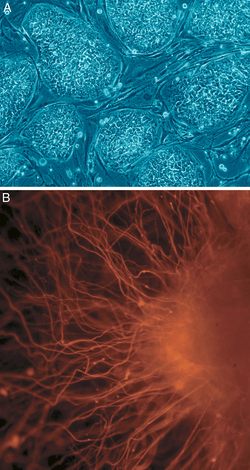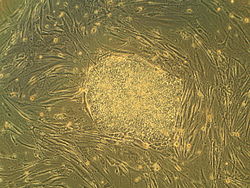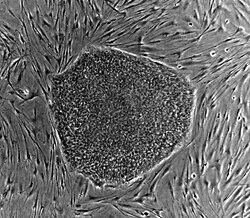Stem cell
Stem cells are cells of the body (somatic cells) which can divide and become differentiated.[1]
When an organism grows, stem cells specialize, and take specific functions. For instance, mature tissues like skin, muscle, blood, bone, liver, nerves, all have different types of cells. Because stem cells are not yet differentiated, they can change. Organisms also use stem cells to replace damaged cells.
Stem cells are found in most, if not all, plants and animals. They divide and differentiate into a range of cell types. Research in the stem cell field grew out of findings in the 1960s.[2][3]
The two broad types of mammalian stem cells are embryonic stem cells, and adult stem cells found in adult tissues. In a developing embryo, stem cells can differentiate into all of the specialised embryonic tissues. In adult organisms, stem cells act as a repair system for the body, replenishing specialized cells, but also maintain the normal turnover of blood, skin, and intestinal tissues.
Stem cells can be grown in tissue culture. In culture, they can be transformed into specialised cells, such as those of muscles or nerves. Highly plastic adult stem cells can be taken from a variety of sources, including umbilical cord, blood and bone marrow. They are now used in medical therapies, and researchers expect that stem cells will be used in many future therapies.[4]
Embryonic stem cells
Embryonic stem cells (ES cells) are stem cells taken from the inner cell mass of the early stage embryo called a blastocyst. Human embryos reach the blastocyst stage 4–5 days after fertilization. At that time, they are made up of between 50 and 150 cells.
The stem cells' state, and what the daughter cells turn into, is influenced by signals from other cells in the embryo.
Adult stem cells
Adult stem cells exist throughout body after embryonic development has completed. They are found inside different types of tissue and remain in a non-dividing state until disease or tissue injury. They have changed permanently into specialised cells and have lost the ability to divide and specialise further. An advantage of adult stem cells is that it provides a lesser probability of rejection. A disadvantage would be that there is a limited availability to get them.
Plant stem cells
Plant stem cells are unspecialised, and can develop into any type of plant cell. They become specialised into cells of roots, leaves or flowers. The stem cells are found in meristem, at root and stem apices. They make it possible for growth to continue.
Cloning plants
These are plants which have been grown from cuttings (therefore the same plant). They are dipped in hormone rooting powder to develop bigger root systems. They turn into tissues (e.g. xylem and phloem) and organs (e.g. roots, leaves and flowers), therefore becoming a completely new plant.
Stem cells in medicine
Some cancers may be treated by stem cells. Leukemia, a cancer of white blood cells (WBC) is an example.
There are two stages to this process:
- Chemotherapy and radiotherapy to kill cancerous white blood cells and stop the production of more. However, this may leave the patient with a severely compromised immune system with a risk of infection.
- A transplant of bone marrow containing healthy stem cells (to produce normal WBC).
Stem Cell Media
Pluripotent, embryonic stem cells originate as inner cell mass (ICM) cells within a blastocyst. These stem cells can become any tissue in the body, excluding a placenta. Only cells from an earlier stage of the embryo, known as the morula, are totipotent, able to become all tissues in the body and the extraembryonic placenta.
Other websites
- Stem cells at the National Academies Archived 2010-04-09 at the Wayback Machine
- Adult stem cells and cloning Archived 2017-09-19 at the Wayback Machine
- National Institutes of Health
References
- ↑ King R.C. Stansfield W.D. & Mulligan P.K. 2006. A dictionary of genetics, 7th ed. Oxford. p425.
- ↑ Becker AJ, McCulloch EA, Till JE (1963). "Cytological demonstration of the clonal nature of spleen colonies derived from transplanted mouse marrow cells". Nature. 197 (4866): 452–4. Bibcode:1963Natur.197..452B. doi:10.1038/197452a0. hdl:1807/2779. PMID 13970094. S2CID 11106827.
{{cite journal}}: CS1 maint: multiple names: authors list (link) - ↑ Siminovitch L, McCulloch EA, Till JE (1963). "The distribution of colony-forming cells among spleen colonies". Journal of Cellular and Comparative Physiology. 62 (3): 327–36. doi:10.1002/jcp.1030620313. hdl:1807/2778. PMID 14086156.
{{cite journal}}: CS1 maint: multiple names: authors list (link) - ↑ Tuch BE (2006). "Stem cells—a clinical update". Australian Family Physician. 35 (9): 719–21. PMID 16969445.






